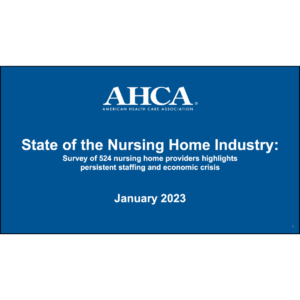Tips for Successful Online Staff Recruitment at Your Senior Care Organization

Val Poltorak, head of US regulated industries at Sterling
When the COVID-19 pandemic prevented in-person hiring events from taking place, the senior care industry had to turn to online staff recruitment, instead. Today, an online presence has become a key element of staff recruitment. To attract quality candidates, particularly in light of the current staffing shortage, senior care organizations need to reevaluate how they are connecting with candidates online, too.
The Growth of Online Staff Recruitment
The pandemic has reshaped the recruitment process for senior care organizations. Val Poltorak, head of US regulated industries at Sterling, a provider of background and identity services, explains that prior to the pandemic, healthcare organizations enjoyed success with camping recruiting events, where companies could engage with student candidates and get them excited about joining the organization’s mission. But the pandemic forced companies to explore other recruitment strategies.
“Companies were investing in online recruiting solutions, developing a bigger brand presence on social media platforms, and encouraging their employees to become referral sources through advocacy via their own social channels,” says Poltorak. “Today, organizations are seeing the advantages of online recruitment, including reaching a wider and more targeted audience, reducing time to hire, creating a better candidate experience, and improving hiring efficiencies.”
Online Staff Recruitment Messaging
With the growing importance of online recruitment, it’s important for senior care communities to leverage their online presence, and that starts with identifying the right messaging to connect with candidates. When it comes to messaging, transparency is essential. “Being transparent about an organization’s mission and values, as well as the positive impact they have on their community, is critical,” Poltorak explains. “Especially for the senior care community, candidates want to know that they are working for a great cause.
“This goes along with workplace culture. Candidates want to be able to understand what kind of company culture an organization has before they consider applying,” she adds. “Not only is this helpful for candidates, but it’s also beneficial for senior care communities as this can help ensure they are attracting and hiring employees who would be a good fit for them.”
In addition to incorporating transparency into marketing, emphasizing advancement opportunities can also help to recruit candidates. “Not only do candidates want to work for a great cause, but many want to challenge themselves and work for an organization that will invest in their professional development,” says Poltorak. “Having a clear path to skilled positions can encourage candidates to apply.”
Marketing for Online Staff Recruitment
When it comes to marketing, Poltorak recommends that senior care communities start by optimizing their website, which is often a candidate’s first impression of the company. An easily accessible, dedicated career page allows communities to create and collect content that is specific for candidates. The website should also be optimized for mobile use, since many candidates use mobile devices when searching and applying for jobs.
It’s also essential to have a quick and simple application process, says Poltorak. “When the application process involves multiple pages and a lot of manual field entries, the likelihood of candidates dropping off increases. Creating a pleasant and simplified experience for the candidate can help them feel comfortable taking the next step with your organization.”
She suggests that senior care communities host online recruiting sessions to broaden their talent pool. Such events allow communities to engage more talent, improve diversity and inclusion, and also eliminate the need to travel.
Social media can also play a key role in increasing the community’s reach and engaging with a wider talent base. The platform is ideal for showcasing a community’s brand and culture. “The possibilities of how you highlight your company are endless,” says Poltorak. Communities might post work events, employee spotlights, volunteer opportunities, and other content with the goal of humanizing the organization. “Having a strong, authentic social media presence also encourages your current employees to be active and engaged,” she says. “Let your employees show through their eyes why they love working for your organization.”
Screening and Securing Top Applicants
The applicant screening process is also integral to an online recruitment strategy. Poltorak notes that because senior care communities serve vulnerable populations, it’s critical that they conduct a robust background check when screening candidates. It’s important to have a background screening partner that understands the senior care industry, including its unique regulatory and compliance requirements.
“With candidate experience being a main differentiator in a competitive talent environment, the overall experience of how the background check is being conducted can be the deciding factor between a candidate taking the next step with you or someone else,” explains Poltorak. A Sterling survey of more than 3,500 job seekers found that 7 out of 10 candidates considered dropping out or have dropped out of the hiring process.
“A longer and more complex background screening process not only increases the chances of a candidate dropping out of the hiring process, but it can also lead to a negative view of the organization’s brand,” says Poltorak. “Having consistent communication with clear next steps for candidates to follow during this important process can greatly improve their experience and excite them for their new job opportunity that awaits them.”

Paige Cerulli is a contributing writer to i Advance Senior Care.
Related Articles
Topics: Business Marketing Including Social Media and CRM , Featured Articles , Staffing











